You might be wondering, can we really teach critical thinking skills to our children? Aren’t these abilities something that kids develop on their own? Or do people manage to think logically without any education in logic and critical thinking?
Regardless of whether children can learn through trial and error, significant information showcases the incredible benefits of learning, practicing, and integrating this skill intentionally.
Estimated reading time: 4 minutes
However, most people don’t realize the crucial need to regulate emotions to access the ability to think logically, so let’s explore further.
What Is Critical Thinking?
According to Philip C. Abrami, “Critical thinking (CT), or the ability to engage in purposeful, self-regulatory judgment, is widely recognized as an important, even essential, skill.
Research further indicates that one of the most effective ways to foster critical and creative thinking for kids is to teach those skills. Studies have also shown that children become better learners when they explain how they solve problems.
Therefore, critical thinking is a process of defining, investigating, and assessing a situation that requires logic and decision-making to a claim, conflict, or argument. This activity involves the ability to think rationally and clearly understand the logical connections between ideas.
The 3 Phases of Critical Thinking
 Description Phase
Description Phase
The descriptive phase describes the situation by defining the goal, restrictions, boundaries, and elements. Keywords used: who, where, what, and when.
 Analysis Phase
Analysis Phase
The analysis phase explains how the different elements fit in the whole story. Keywords used: why, how, and what if.
 Evaluation Phase
Evaluation Phase
The evaluation phase assesses the various alternatives and their impact on solving the issue. Keywords used: so what, and what next.
If you want your child to carefully assess situations and offer innovative solutions, you need to assist them in developing critical and creative thinking skills from early on.
The good news is that, like any other skill, critical and creative thinking skills can be cultivated and strengthened with the help of certain thinking strategies, which we’ll discuss in the latter part of the article.
Related reading: "Critical Thinking" by the New York Times
Benefits of Nurturing Critical Thinking in Children
Critical thinking isn’t just an academic skill—it’s a foundation for life. When children learn to question, reflect, and problem-solve, they’re building mental flexibility that serves them in every area of life.
Encouraging critical thinking equips kids to navigate challenges with confidence, creativity, and resilience.
There are myriad benefits of promoting thinking skills in children and teens. Here are just a few of the lifelong benefits of developing this essential skill.
- Enhances creativity by making your child imagine innovative ideas to tackle situations.
- Stimulates curiosity as it encourages your child to ask questions, explore and examine various alternatives to solving problems.
- Prepares your child to become instinctual problem-solvers and face complex issues head-on.
- Is a skill for life—no matter what path your child chooses in life, their ingenious thinking approach will help them overcome life challenges.
Strategies to Spark Critical Thinking in Children While Cultivating Creativity
 Give a Connection Challenge
Give a Connection Challenge
When your child is able to make connections to other known things, they strengthen their understanding of the subject. Encourage your child to connect the current topic of conversation to something else you have talked about earlier.
For instance, when you read a story together, ask your child how the current story relates to another story you have read together a few days back.
There might be no obvious connection, but your child can come up with one that could be insightful or just plain vague. Whatever connection your child makes, ask them to explain their answers. When they explain, they converge their thoughts about each story (critical thinking) and look for a not-always-obvious connection (creative thinking).
 Employ Analogies to Build Relationships
Employ Analogies to Build Relationships
Analogies allow your child to make connections at an advanced level. This thinking strategy involves relating previously learned concepts as well as generating new comparisons.
Working with analogies helps your child generate creative ideas, see complex relationships, and make unusual comparisons.
For instance, ask your child, “how is thinking like a volcano?” Analogies like this stimulate your child’s imagination, develop deeper understandings, and help make connections that appear impossible.
 Encourage Varying Points of View (POV)
Encourage Varying Points of View (POV)
This thinking strategy allows your child to explore an idea from multiple perspectives. Stretching the mind to see a problem or idea from different perspectives helps broaden their thinking and demonstrates that an idea should be evaluated from different perspectives before an opinion is formed.
You can help your child recognize different viewpoints through books, stories, conversations, and movies. The main objective is to encourage a discussion of questions that have no definite answers.
For example, “what makes a person a good human?” is an open-ended question that can spark ideas without a definitive answer.
Related reading: “Positive Parenting: 3 Parenting Strategies for Greater Patience.”
 Explore Personification
Explore Personification
Using personification, you can ask your child to compare different objects.
For example, if you are working with colors, ask your child, “what did a green say to a red?”
This mental exercise encourages your child to think of the qualities of each color (critical thinking) and imagine how these qualities could translate into human actions and emotions (creative thinking).
 Experiment with Another Way
Experiment with Another Way
When your child learns something, ask them to show what they’ve learned using another way. For example, if your child has learned the number “ten,” ask them to show it differently.
They may show it in a different color, may bring ten spoons, or may draw ten dots. Inquiring about different ways of expressing knowledge helps deepen their understanding of the number ten (critical thinking). And by representing it in different ways, they are also thinking creatively.
Closing
The above thinking strategies can sharpen your child’s critical and creative thinking skills and make them more effective and independent learners.
Try out these strategies to improve your child’s critical thinking, broaden their creative powers, and help them succeed in their academic and personal lives.
For more on teaching children critical thinking skills and for parenting support, check out Heartmanity's HeartPrints Resources or sign up for our newsletter so you don't miss other great content!










